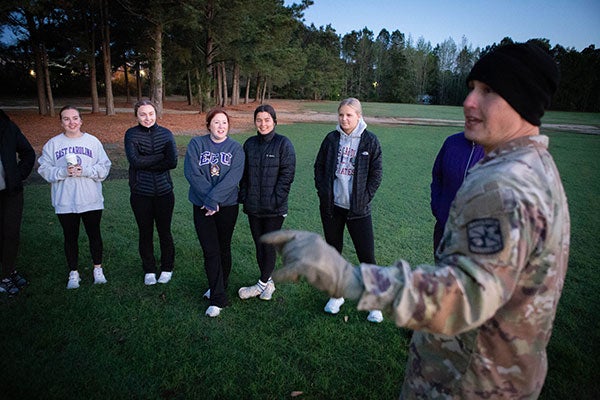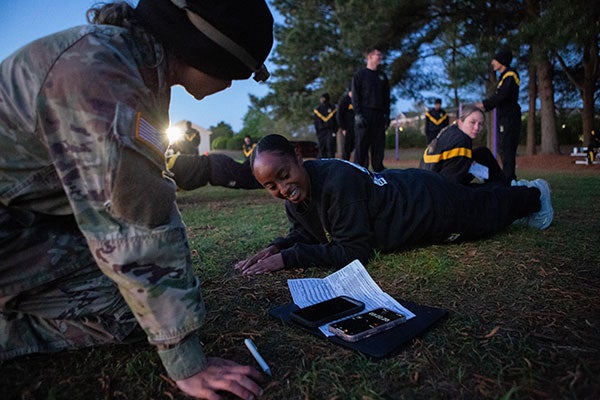ECU’s interdisciplinary approach enhances ROTC cadet wellness
On an unseasonably brisk April morning, a dozen or so students in a calliope of East Carolina sweatshirts and winter coats shivered against the cold, laughing and watching as a man in a U.S. Army uniform prepared them for what they were about to watch.
When the cadets reached the sprint-drag-carry event — one in a series of required physical tasks in the Army Combat Fitness Test — an ROTC instructor told the students near him to watch some of the cadets run to the wood line.
They didn’t prepare well for the test. They would be throwing up, the soldier said. But they were less likely than before to be injured, the result of a unique partnership between faculty and student researchers from across the university.
Foundations of a Partnership

Maj. Steven Cross, an ECU professor of military science, explains the process of the Army Combat Fitness Test to physical therapy students in the early hours of April 9.
At the end of 2020, the Army proposed a cultural shift in the way it trains soldiers in body, mind and spirit — a revolutionary approach to making, and keeping, America’s warfighters prepared to defend the nation, referred to as Holistic Health and Fitness, or H2F.
In spring 2023, Dr. Stacey Meardon, assistant professor of physical therapy and the interim chair of the PT department, received a call from a main campus number. Then-Capt. Steven Cross, an ECU assistant professor of military science, noticed a troubling trend in his cadets: recurring injuries associated with running, a staple of Army life. He planned one of his own Graduate School projects to reach out to other parts of the ECU community to find a comprehensive solution to the spate of injuries he was juggling in his cadet corps.
“In the literature right now step length, stride and cadence are popular evidence-based ways to look at running injuries. He came over and we went downstairs to the lab and spoke with physical therapy associate professor John Willson, and we discussed how, as physical therapists, we recognize that injury isn’t just about one thing. How you run can contribute to injury, but other factors can increase or decrease that effect,” Meardon said.
Their discussion branched out to the cadets’ advance camp requirement in their junior year — a monthlong, physically demanding leadership experience. Students would depart Greenville for the next advance camp in just a few months, not nearly enough time to really prepare cadets to prevent injuries resulting from physical overload, but it was a start.
At the same time, one of Cross’ ROTC students was pursuing a research project with Meardon, which Cross called a “tremendous opportunity” to join resources across the university. What started as a purely educational opportunity blossomed into more.
“The physical therapy department has graduate students who need practical experience developing and implementing health promotion projects as part of their coursework, and we are a population doing physical training. We sustain injuries,” Cross said.
Coincidentally, before she first met with Cross, Meardon was asked to present data from her physical therapy research to members of the Holistic Health and Fitness (H2F) at Fort Bragg. But getting that data into that format compatible with Army data systems required help from Scotty Stroup, ECU’s director of enterprise data services.
Soon, Dr. Michael Garrison, a physical therapy clinical associate professor and former Army officer, began mentoring the third-year cadets tasked with preparing physical training plans and the seniors who provide quality control for their junior peers. As the relationship developed, Cross and Meardon sought ways to formalize the tangle of processes.
The first step was assessments of strength, flexibility and any existing injuries. Next came informal clinics, where PT graduate students transitioned assessments into hands-on injury-prevention strategies.
At the same time, Cross and the ROTC program began working with Dr. Christine Habeeb, an associate professor of kinesiology in the College of Health and Human Performance, to provide the cadets training in sports psychology, confidence and leadership. Habeeb provided initial contacts with units at Fort Bragg through some of her former students who have positions within the H2F program on post.
“We saw an opportunity where we could use our university departments to build our own H2F program here,” Cross said.
With connections at Fort Bragg, Cross set up a visit for Meardon and some of her graduate students to see how the Army had already put the resources behind integrated care for military athletes.
After visiting 82nd Airborne Division units at Fort Bragg, Meardon believed the H2F program could be a model for how to help ECU’s ROTC program prevent injury and expose future health care professionals to a model of integrated care that they might carry with them after graduation.
While the Army has a more integrated, less siloed health care delivery system, providers may face limitations in using analytics effectively. Meardon said the data analysis systems being developed at ECU might transfer to the Army — dashboards that integrate physical fitness, nutrition, behavioral health, and inputs from sports psychologists. This level of communication would give providers a comprehensive view to strengthen bodies and prevent recurring injuries.
From Research to Practice

An ECU Army cadet performs a plank while taking the Army Combat Fitness Test.
Habeeb’s research focus is on how teams and people perform; she sees working with cadets — and her faculty peers and student researchers in other colleges — as a perfect fit.
“What we’re trying to do is use faculty expertise across ECU to help our cadets,” Habeeb said. “The more we get involved, the more we see opportunities.”
At first her focus was on research. But after seeing that the cadets require the same level of support as student athletes, but receive much less, Habeeb resolved to combine research with direct intervention.
Master Sgt. Heath Weisiger, the senior military instructor at ECU, came to the Pirate brigade from Fort Bragg. A full career of leading soldiers in Iraq and Afghanistan showed him the importance of guarding the health and well-being of those in his charge.
Weisiger said the Army’s current physical fitness test is more taxing than past versions as it requires different musculature than past tests, which results in fitter soldiers – but injuries resulting from training persist.
“I felt like the injury rates weren’t very much different when we took the old PT test. Lower back injuries, knee and ankles from running and rucking,” Weisiger said. “But soldiers are more physically fit.”
It costs a lot of money to train people who are asked to perform at the highest levels, Habeeb said, and even more to return them to a functional level in the event they are hurt.
“What we want them to do is train smarter and not harder, right? An old principle was just go, go, go, go, go, and we are recognizing in our research that doesn’t work. It’s not the best for people individually and it’s not the best for the military overall, either,” Habeeb said.
Habeeb said she hopes to take the lessons she is learning from her interactions with the ROTC students and find ways to apply them to teach teamwork and leadership in business, health and education.
Teaching Health Care Students

A member of ECU’s Army ROTC Pirate Battalion runs around the North Recreational Complex as part of the Army Combat Fitness Test.
The PT department already offered a health promotion course, but after meeting with Cross, Meardon returned to her faculty colleagues and proposed tweaking her project’s focus from bone injuries to a broader approach — one that addresses the complex interplay between bones, muscles and other soft tissues.
Kali Huck, a New Jersey native in ECU’s physical therapy program, is part of the cadre of students working to prevent injuries in the Pirate cadets — an important task because they are “the future military men and women of our nation.”
While being up well before dawn on a chilly morning wouldn’t be her first choice, Huck said being able to see her peers taking the physical fitness test would give her a perspective she couldn’t get any other way.
“It’s good to see them in their natural environment. To see what they are going through helps us to see their body mechanics which gives us a clue about why they may be injuring themselves,” Huck said.
Jessica Welsh, a physical therapy student from Maryland, said, like Huck, she initially wanted to work with sports therapy but increasingly is interested in providing therapy for neurological patients. But she holds a soft spot for those in uniform after completing a rotation at the Veterans Affairs clinic in Greenville. Those patients were older, and Welsh said she saw the cumulative toll on bodies.
“There are a lot of veterans in eastern North Carolina and there were only a few patients that I got to see more than once, so being able to get out and be in the field with them is very important,” Welsh said.
Once the PT staff and students started working with cadets, Meardon said they started to notice other gaps in preventive care that a variety of specialties could help bridge, including team psychology, mental health and nutrition.
Empowering students from across ECU to use the skills they are learning in class to be part of an interdisciplinary team before they graduate gives them an incredible leg up, Meardon said. Physical therapy students don’t necessarily have a lot of practice harnessing data, so including those from HHP who are more experienced is important for the team to work.
“It’s incredibly important for them to be part of the solution. They are key stakeholders in a unique model,” Meardon said.
If people are an organization’s greatest assets, Meardon said, they should be cared for holistically. She stresses to her physical therapy students the need to expand their focus while treating patients: screen for nutrition, mental health and the resources they have and don’t have that will improve their overall wellness.
Meardon said the interprofessional training her students — and the others from across ECU’s campus — receive now will help them break down the silos that she feels have stagnated transformational health care. Some days it feels like the steps she and her peers are taking are too incremental to add up to much, but Meardon believes there are peaks of light.
“Sometimes you get caught up in the day to day of what you do. And then I sit in these meetings, and I get goosebumps from being excited about what’s going on,” Meardon said. “The big wins are hard to come by; it’s the little wins that add up.”
